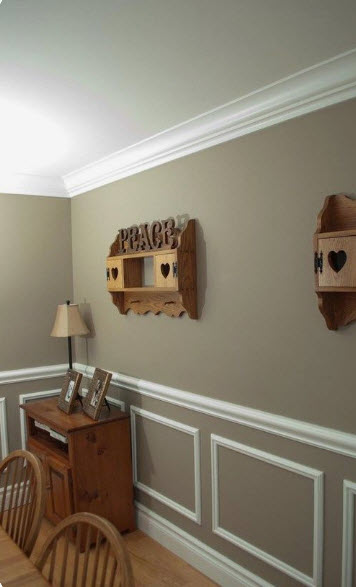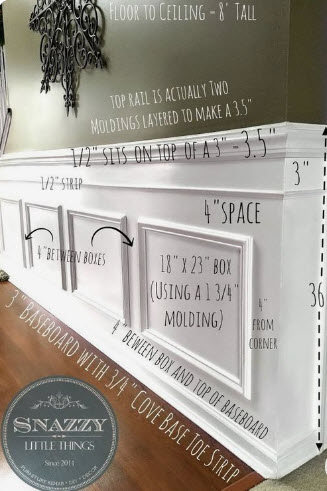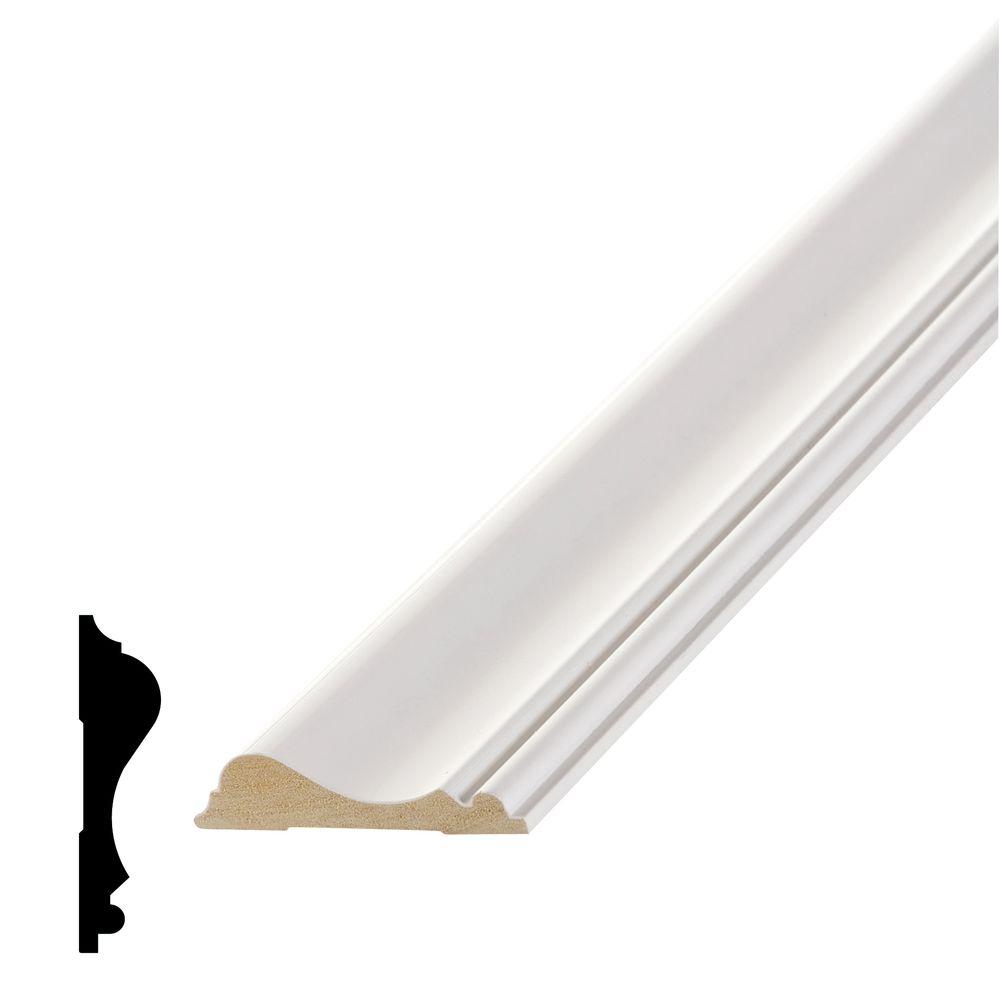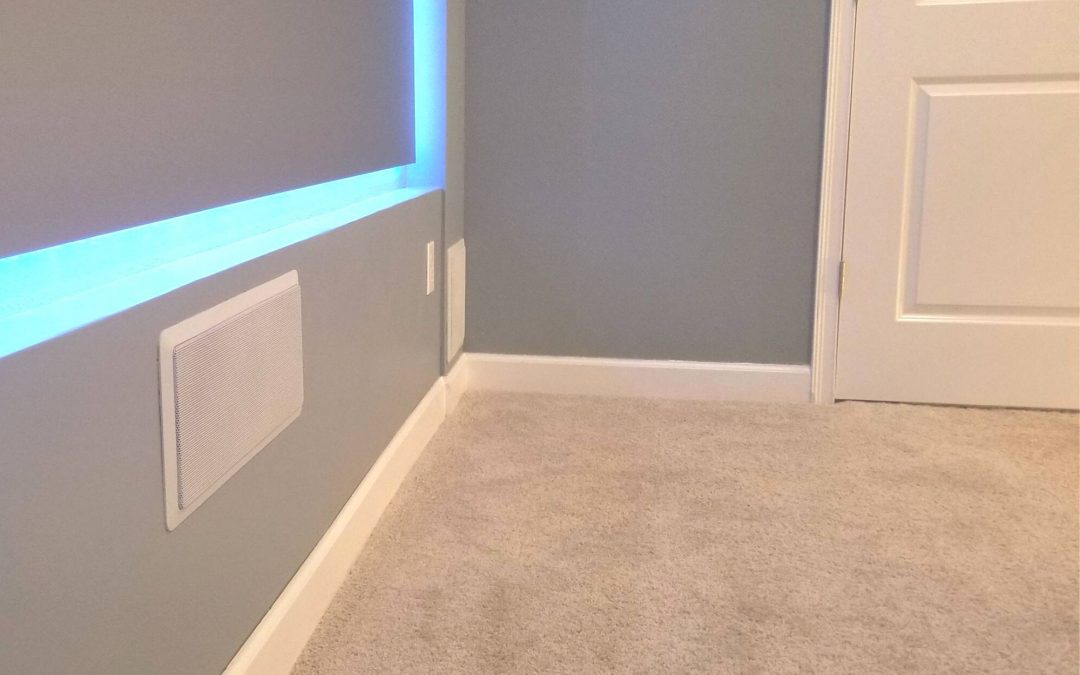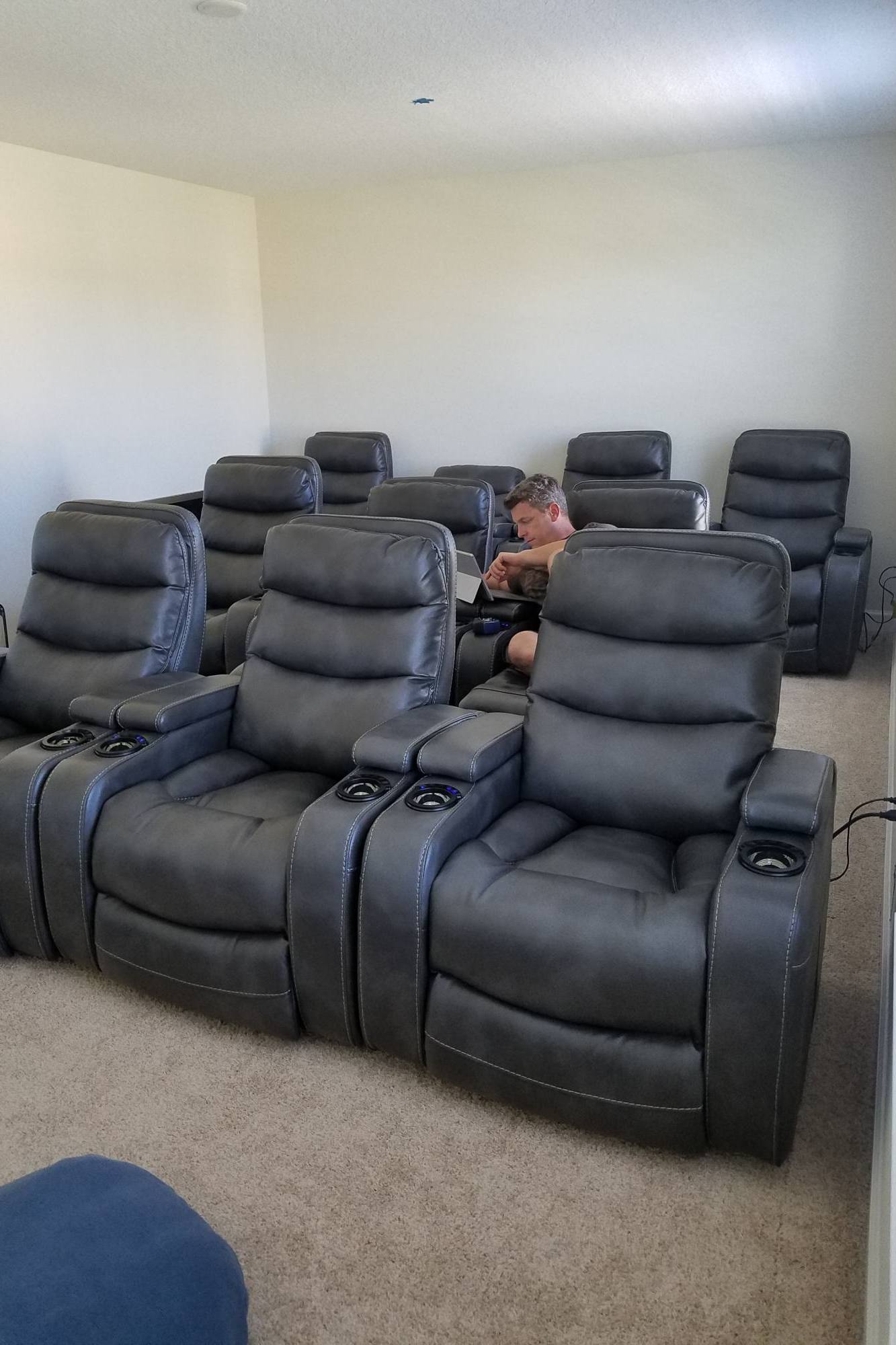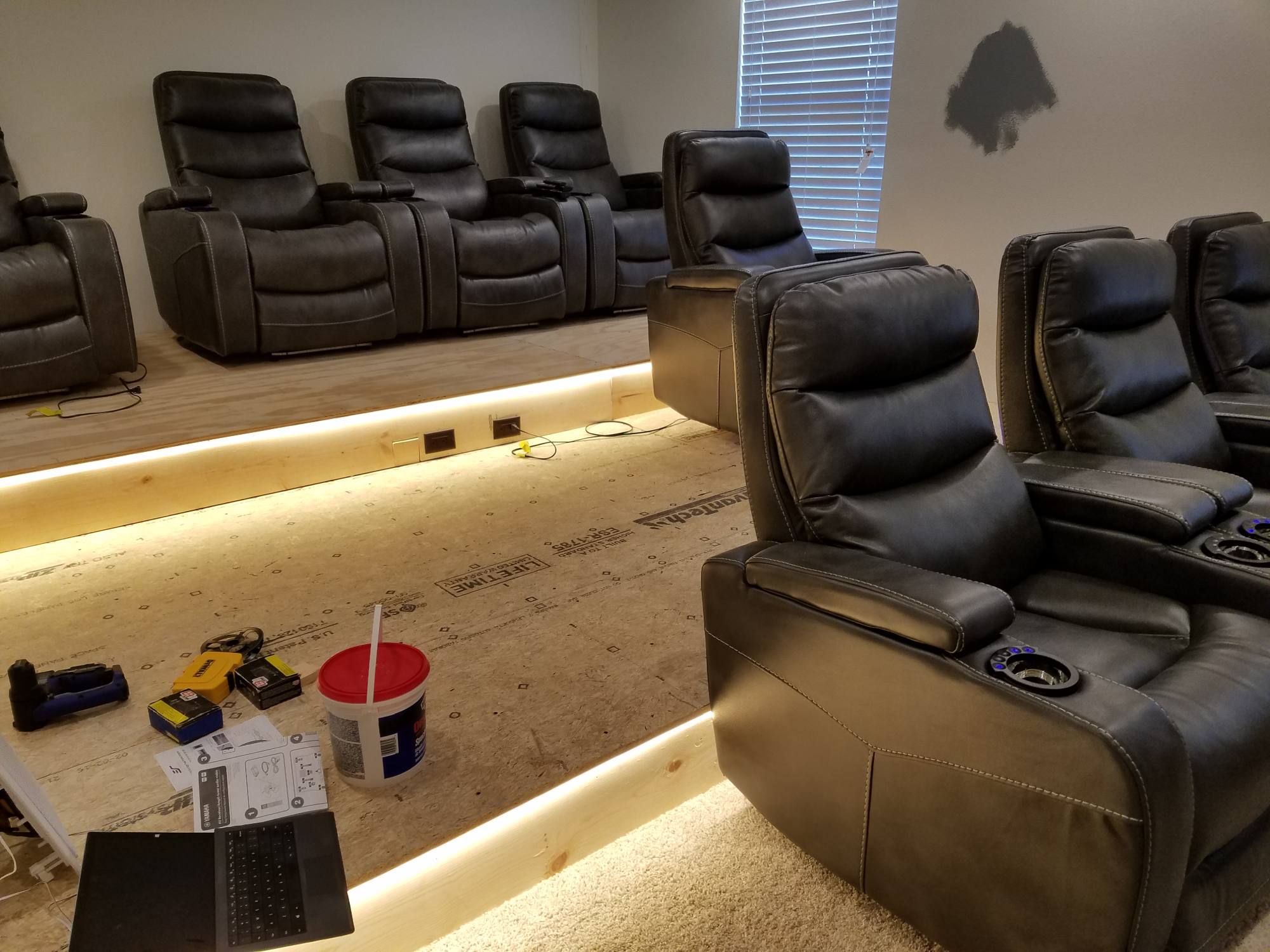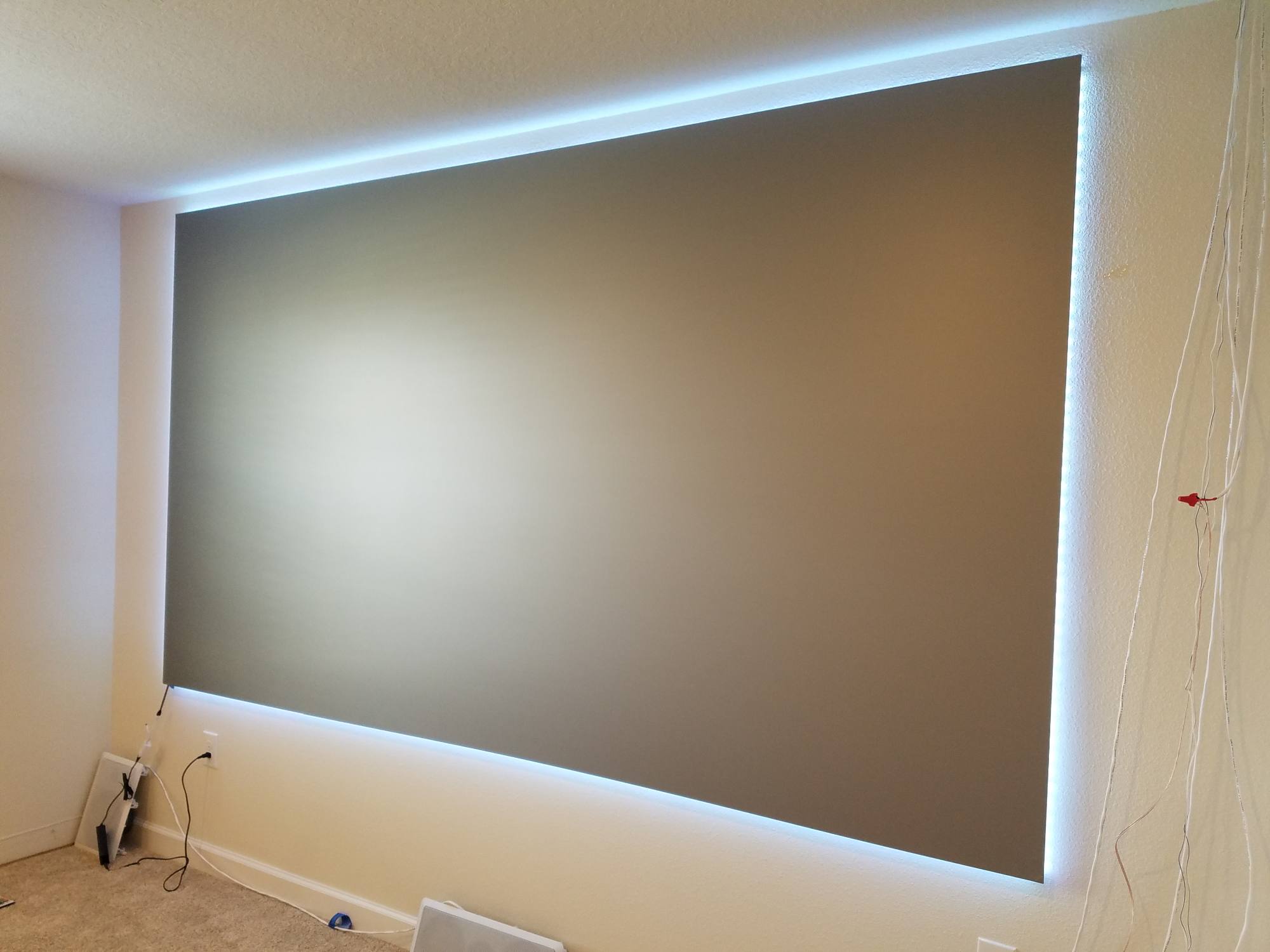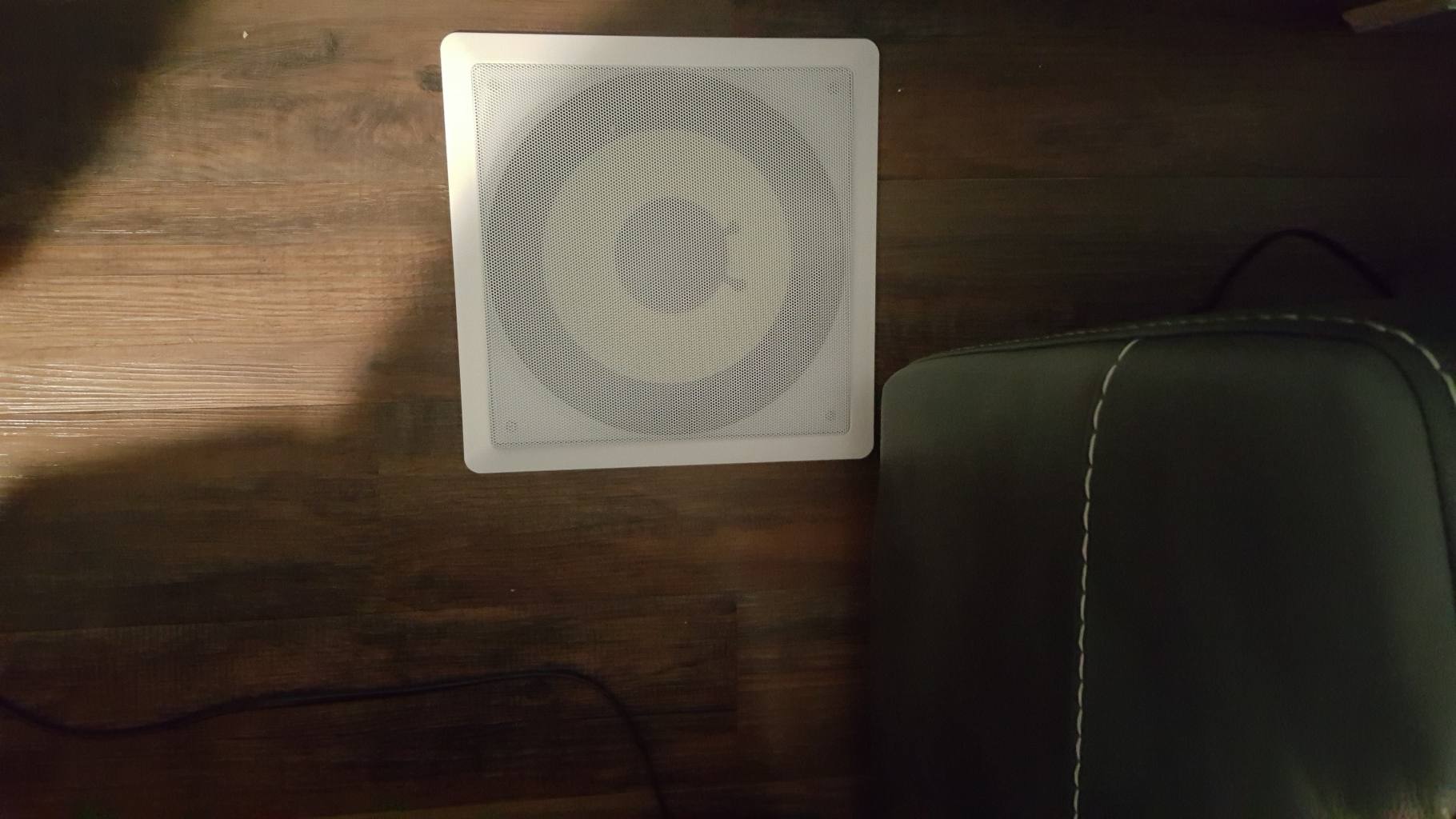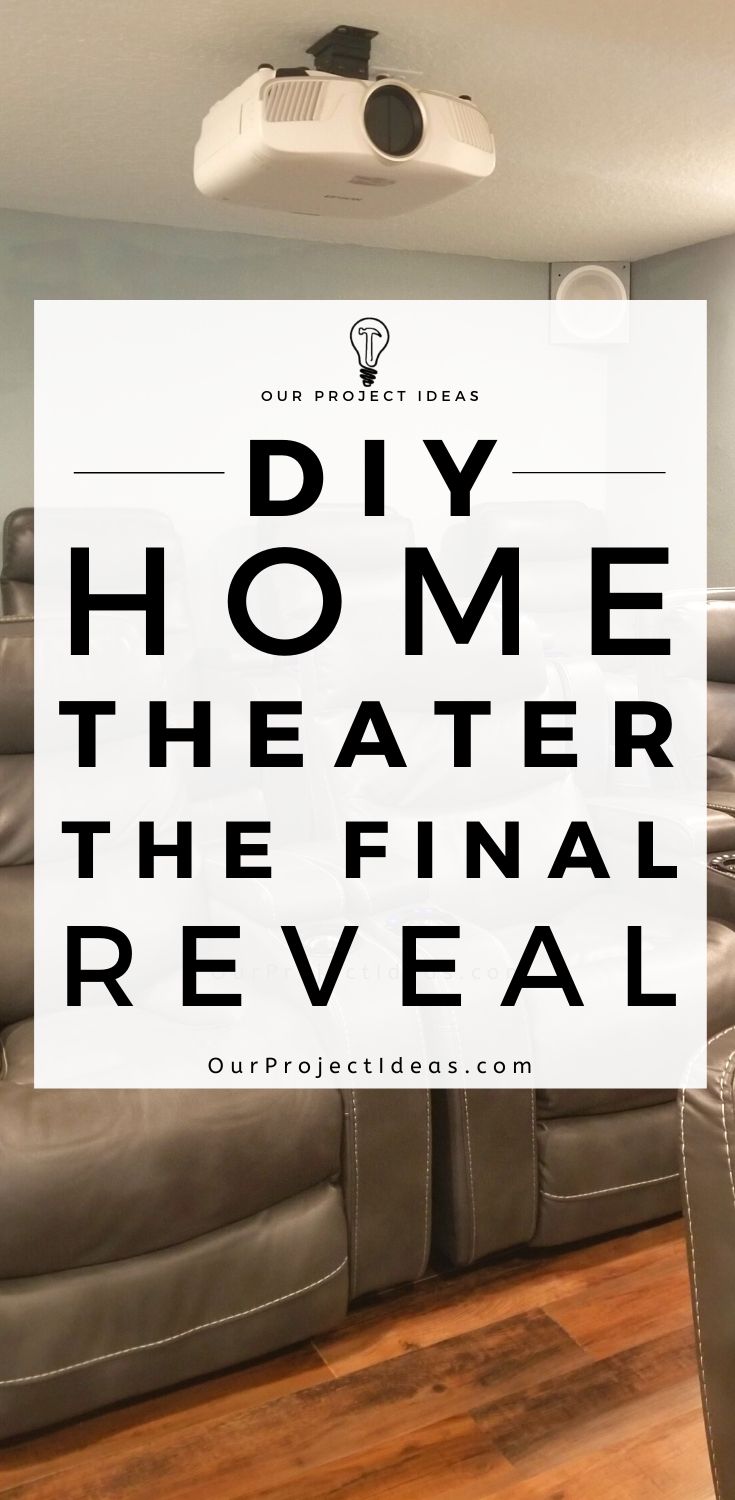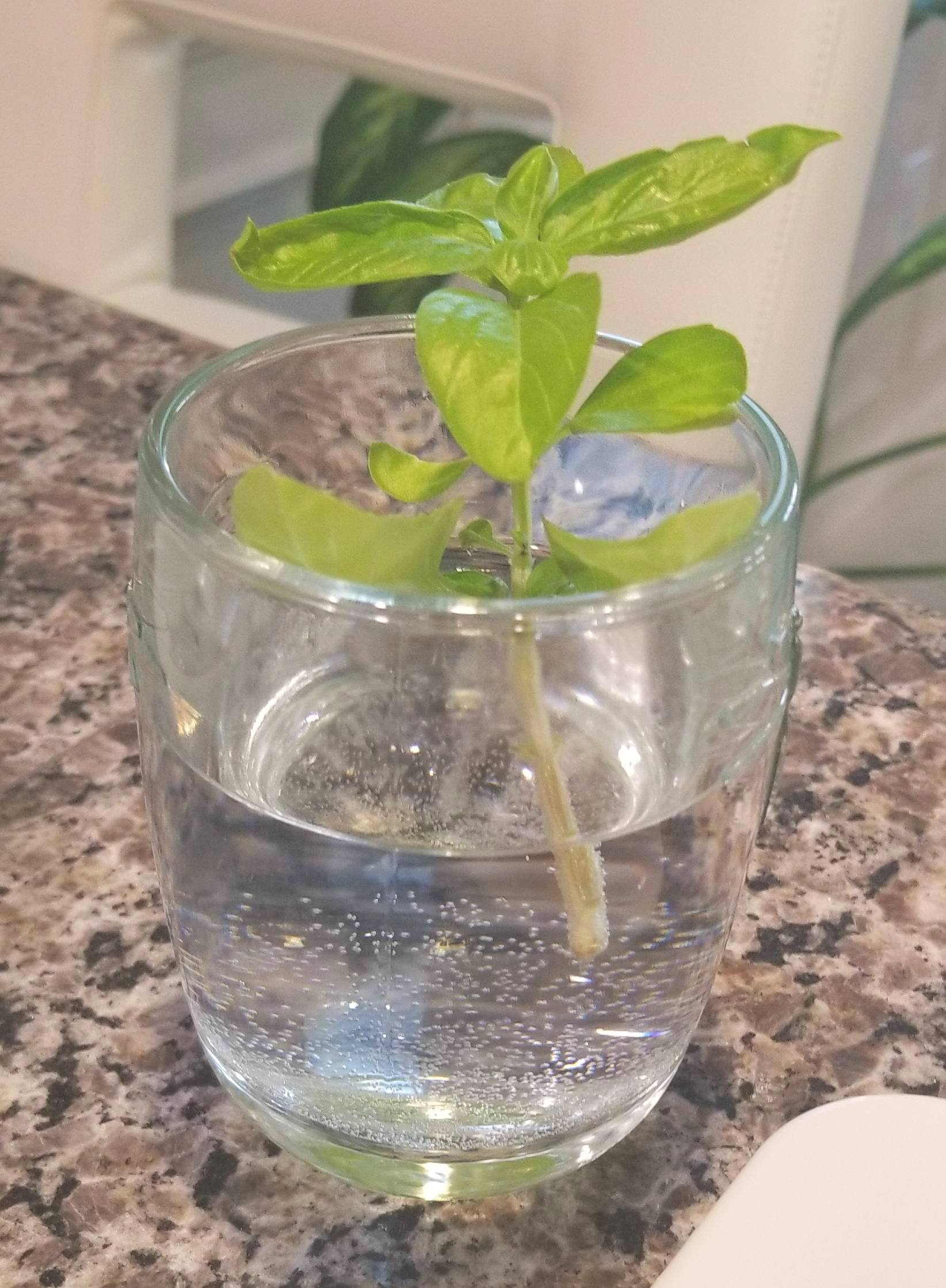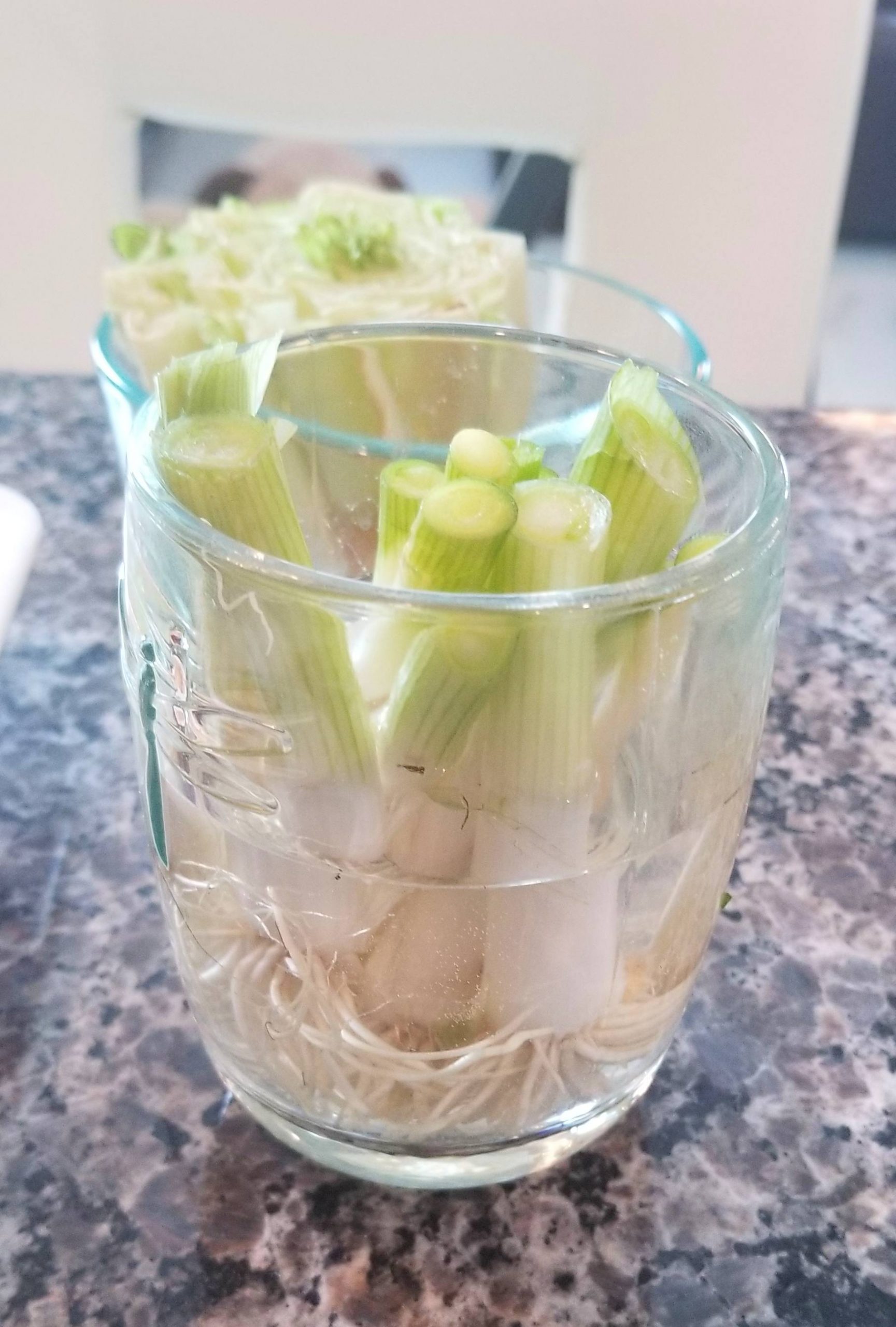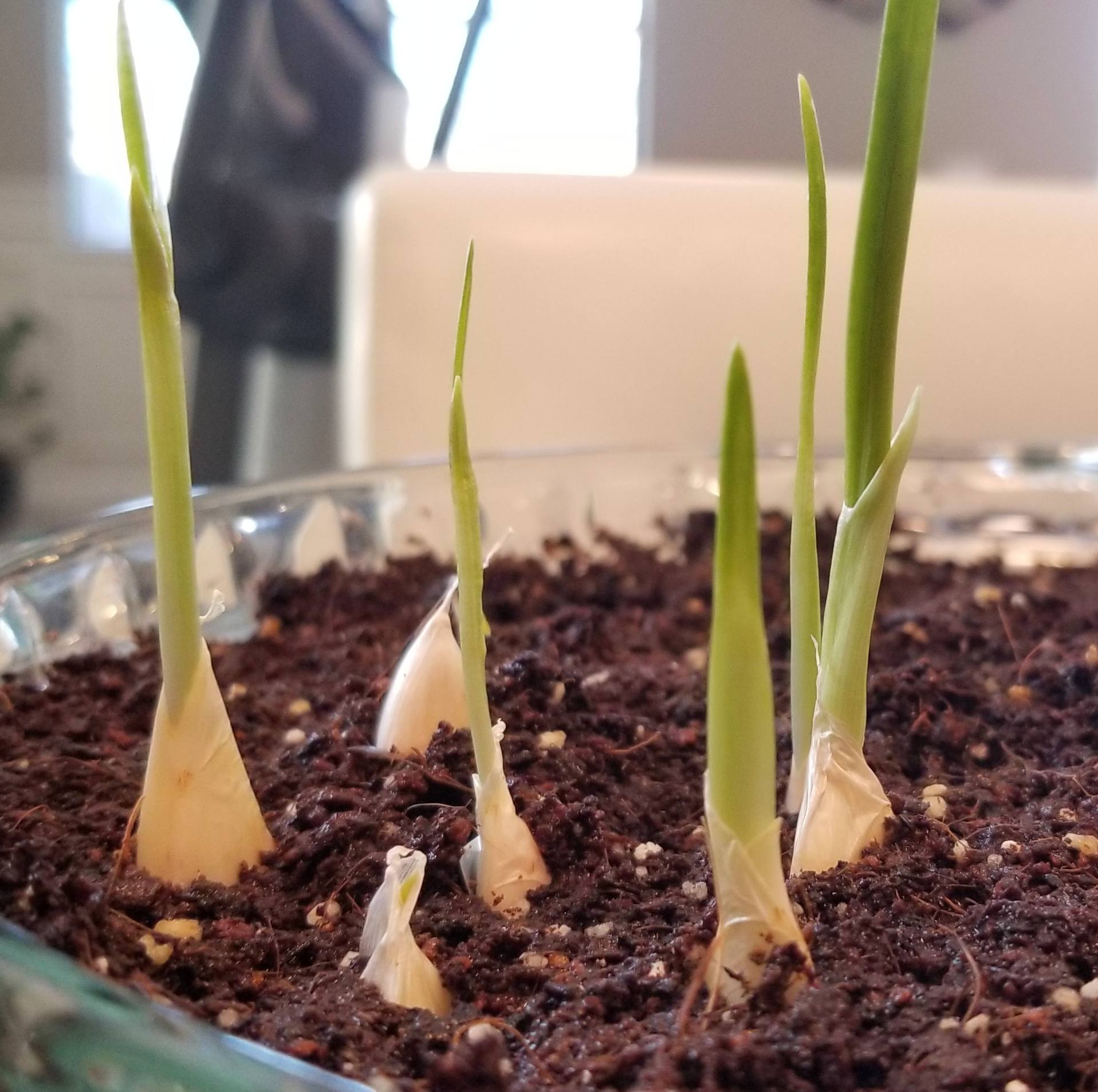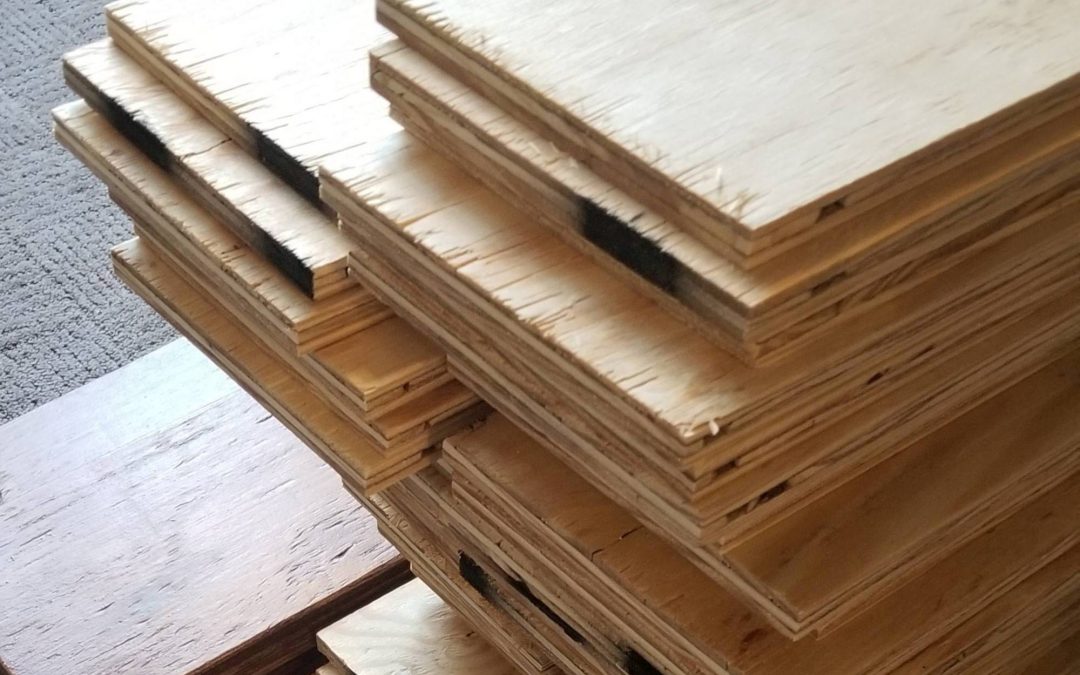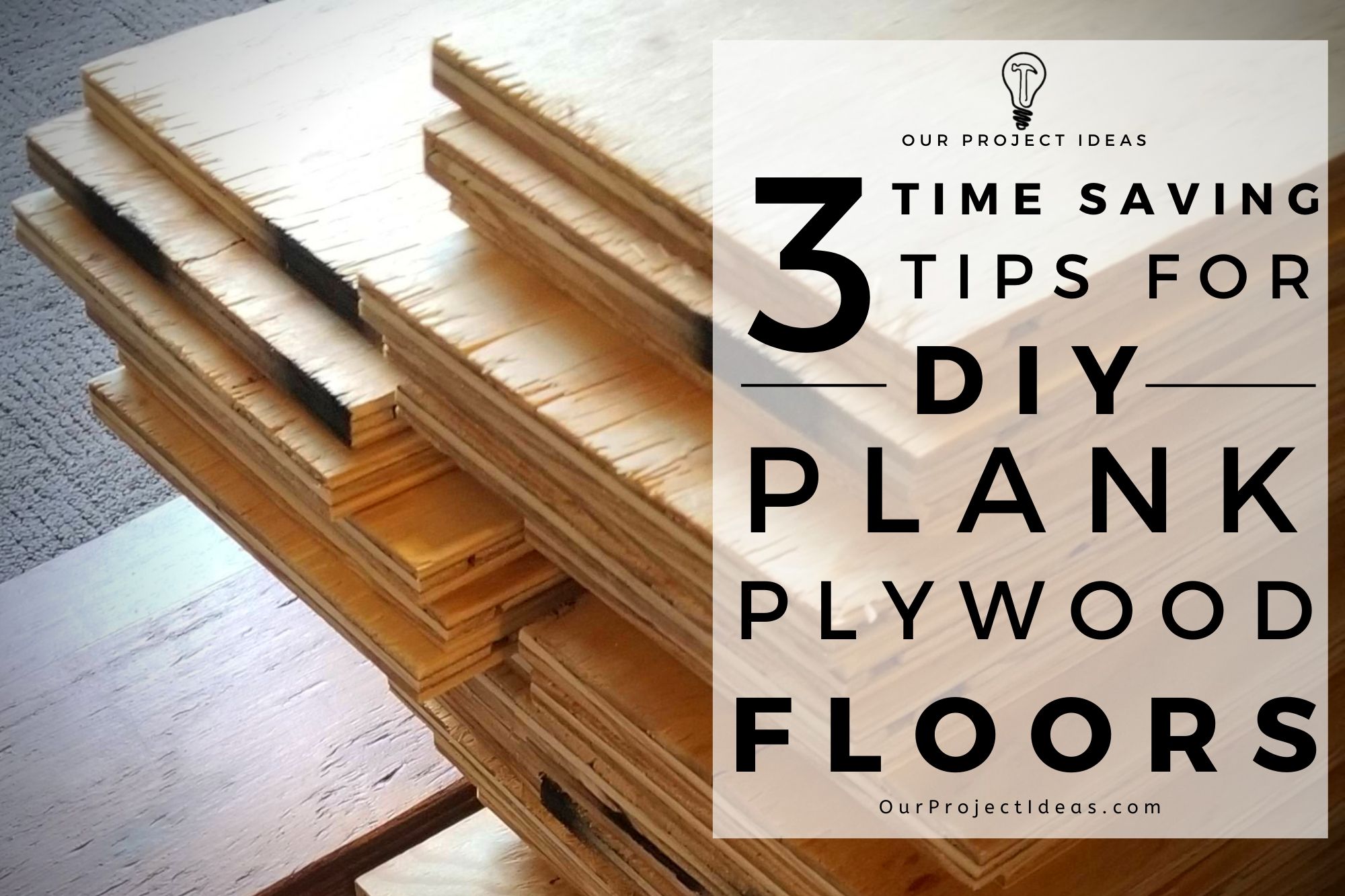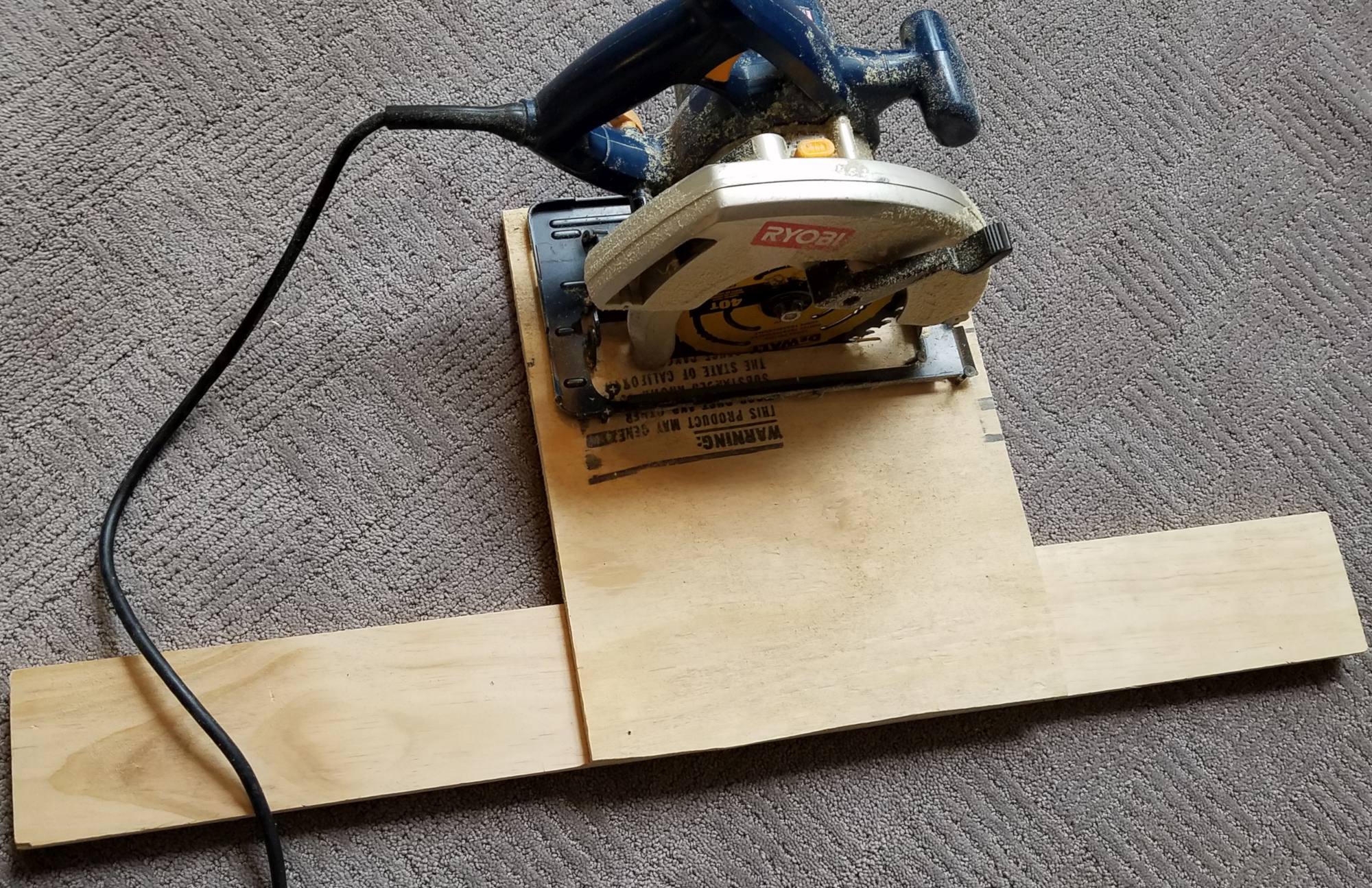
Lambris de bricolage – Partie 1 – Conception et mise en page

Si vous recherchez des lambris sur Pinterest, vous trouverez toutes sortes de styles et de versions différents de lambris., du super simple à l'incroyablement orné.
Je voulais un design de lambris élégant sans en faire trop et je ne voulais pas qu'il soit trop difficile à installer..
Je pense que ce que nous avons choisi a fait exactement cela, il a ajouté une tonne de style et de caractère et a fière allure. Et cela n'a pas pris beaucoup de temps à faire.
J'ai d'abord fait les lambris du rez-de-chaussée, puis environ un an plus tard, j'ai décidé de faire aussi des lambris à l'étage. Si j'additionne le temps entre l'étage et le rez-de-chaussée, cela a probablement pris au total environ 2 semaines pour les deux.… mais gardez à l'esprit que ce sont des espaces assez grands.
Le projet va être décomposé en un tas de posts.
Dans cet article, nous nous concentrerons sur le design que nous avons choisi et pourquoi nous l'avons choisi., comment nous avons trouvé nos dimensions de lambris, et comment mesurer les lambris.
Ensuite, dans les prochains articles, nous reviendrons sur la découpe des lambris., installer les lambris et je pense en faire un autre sur les lambris dans les escaliers, (alerte spoil, il y a plus de maths mdr).
Peu importe le style que vous choisissez, vous trouverez ici des conseils pour rendre votre installation plus fluide.
Je pense que le secret pour installer des lambris consiste à utiliser des gabarits et des entretoises.. Étant donné que la plupart des pièces du lambris ont la même taille, vous pouvez créer des modèles pour les couper plus rapidement et les entretoises permettent un espacement constant sans avoir à mesurer chaque espace..
L'utilisation de modèles et d'entretoises avec vos lambris de bricolage aura un impact énorme sur la durée de votre installation..
Divulgation: Certains des liens ci-dessous sont des liens d'affiliation. Si vous décidez d'acheter un de ces produits, nous gagnons une petite commission sans frais supplémentaires pour vous. Nous recommandons ces produits parce que nous avons de l'expérience avec eux et de les utiliser pour nos propres projets. En tant qu'Amazon Associates, nous gagnons des achats éligibles.
Choisir un style de lambris
Nous avons examiné de nombreuses épingles de lambris Pinterest pour en trouver une qui corresponde au style que nous avions en tête..
Honnêtement, si vous ne savez pas quel style vous aimeriez, faire une recherche sur Pinterest est un excellent moyen de découvrir les choix qui s'offrent à vous.
Bien sûr, si vous aimez le lambris disposition et moulures que nous avons utilisées, n'hésitez pas à copier ce que nous avons fait. 🙂
Idées de lambris de bricolage – Il y a tellement d'options
Il y a tellement d'idées de lambris, et ils sont tous superbes à leur manière.
Jetez un œil aux différentes dispositions de lambris qui existent sur Pinterest, faites une recherche et vous trouverez d’innombrables modèles de lambris. Si vous ne trouvez pas exactement ce que vous voulez, créez votre propre saveur de lambris en mélangeant un ou deux motifs que vous aimez.
Voici quelques-uns dessins de lambris que nous avons aimé:
L'épingle qui nous a inspiré
C'est l'épingle qui a inspiré notre style de conception de lambris.. Nous avons adoré son apparence et avons adoré la deuxième moulure horizontale entre les boîtes ou les cadres et la moulure de la chaise..
La conception des lambris que nous avons utilisée
Notre saveur de lambris diffère de l'épingle qui l'a inspiré de plusieurs manières – mais je pense que tu peux voir la similitude.
Les différences:
- Utilise une deuxième moulure horizontale plus lourde (c'est le même que celui que nous avons utilisé pour les cadres de lambris)
- La chaise est-elle moulée plus haut (donc il était aligné avec le bar de la cuisine en bas et le demi-mur à l'étage)
- Utilisez des rectangles debout au lieu des carrés ou des rectangles couchés (ce qui semble assez courant)
- Nos espaces autour des places sont des 3 1/2″ (la largeur d'un morceau de 2×4)
Le style
Nous avons examiné de nombreuses épingles de lambris Pinterest pour en trouver une qui corresponde au style que nous avions en tête..
Nous avons aimé que les cadres de lambris soient plus rectangulaires que carrés et plus hauts que larges..
Initialement, nous allions seulement avoir la moulure de la chaise au-dessus des cadres, mais après l'avoir essayé, nous avons réalisé qu'il lui fallait un petit quelque chose en plus, nous avons donc ajouté une autre moulure horizontale entre la moulure de la chaise et les cadres.
Le Wainscoter Hauteur
Jusqu'à quelle hauteur voulez-vous que vos lambris aillent?
Je suis tombé sur un article qui traite en détail de la hauteur des lambris.. Son conseil était d'utiliser la règle des tiers, ce qui signifie que les lambris ne doivent pas dépasser le tiers de la hauteur du mur..
Voici le lien si vous souhaitez en savoir plus.
Je n'ai découvert l'article qu'en commençant à écrire ce post, mais même si je l'avais déjà rencontré, Je n'aurais probablement toujours pas suivi la règle des tiers. En effet, pour chaque étage, nous voulions que la hauteur des lambris s'aligne avec quelque chose d'autre dans l'espace. – et ça ne correspondait pas à un tiers de la hauteur du mur.
Au premier étage, c'était le dessus du bar de la cuisine et au deuxième étage, c'était le demi-mur du grenier..
Si vous essayez de trouver une hauteur à utiliser, Essayez la règle des tiers, ou alignez-le avec autre chose dans l'espace, ou s'il n'y a rien dans l'espace avec lequel vous souhaitez que les lambris s'alignent, vous pouvez utiliser les mesures que nous avons utilisées comme point de départ et les ajuster comme bon vous semble.. 🙂
La hauteur (du sol jusqu'au sommet de la moulure de chaise) au 1er étage il y avait 41″ et la hauteur au 2ème étage était de 41 1/2″.
Déterminez la largeur du cadre
C'était l'une des plus grosses pierres d'achoppement pour moi lorsque j'ai démarré ce projet.. Comment allais-je faire en sorte que tous les cadres aient la même largeur?
Puisque tous les murs sont de tailles différentes il semblait impossible de les faire tous de la même largeur… et bien – c'est.
J'ai finalement compris que chaque cadre de lambris n'a pas besoin d'avoir la même largeur ni même la même hauteur.. En fait, il est impossible pour eux d'être la même largeur car les tailles de mur seront toutes différentes.
Je ne voulais pas que les cadres soient de forme carrée si je pouvais l'éviter et, en fonction de la hauteur des lambris, j'ai visé des cadres d'environ 18 pouces de large..
J'ai fait un outil que vous pouvez utiliser pour calculer la largeur des cadres d'image, Vérifiez-le en cliquant sur le bouton ci-dessous.
Les dimensions des lambris
Je voulais souligner ceci. Les dimensions des lambris seront différentes pour chaque mur que vous réaliserez. Les dimensions du cadre de lambris sur un même mur seront les mêmes, Mais ils seront différents quand sur un nouveau mur, car plus probablement que le nouveau mur sera une largeur différente.
En effet, même si la hauteur du cadre reste la même, la largeur du cadre de lambris changera en fonction de la largeur du mur et du nombre de cadres de lambris.
L'espace autour des cadres
L'espacement entre les cadres est LA chose qui doit être cohérente. Gardez l'espacement le même et votre cerveau pense que toutes les cadres d'image sont de la même taille.
Tant que l'espacement autour des cadres est le même, tout ira bien..
Pour le nôtre, nous avons choisi un espacement de 3 1/2″ tout autour de chaque cadre, comme ça on pourrait utiliser des morceaux de 2×4 comme entretoises. 😉
Le Wainscoter Mesures que nous avons utilisées
L'image présente toutes les mesures de lambris que nous avons utilisées.
Parce que chaque mur a une largeur différente, le les dimensions des lambris pour chaque mur doivent être différentes.
Toutes les dimensions de les cadres de lambris sur le même mur sont les mêmes.
Toutes les mesures sur la photo restent les mêmes pour chaque mur de la pièce, Sauf pour la largeur du cadre de lambris (16 5/8″ sur la photo) qui changera en fonction de la largeur du mur et du nombre de cadres utilisés sur le mur.
Nous savions que la hauteur totale des lambris était de 41 1/2″ (s'aligner avec la hauteur du demi-mur dans l'espace) nous avons donc travaillé à rebours à partir de cette mesure.
Nous avons placé le haut de la moulure de chaise à 41 1/2″ et j'ai placé la plus petite moulure horizontale en dessous pour voir quel espacement entre elle et la moulure de la chaise nous convenait. Nous en avons trouvé 3″ (l'épaisseur de notre niveau).
Parce que je savais aussi que j'allais utiliser des morceaux de 2 x 4 comme entretoises, je pouvais maintenant déterminer la hauteur des cadres des lambris..
Voici comment nous avons calculé la hauteur des cadres de lambris.:
| La hauteur totale du lambris | 41 1/2″ |
| Moins l'épaisseur de la moulure de la chaise | – 2 3/4″ |
| Moins l'espace sous la moulure de la chaise | – 3″ |
| Moins la deuxième épaisseur de moulure horizontale | – 1 1/4″ |
| Moins L'espacement au dessus du cadre | – 3 1/2″ |
| Moins L'espacement sous le cadre | – 3 1/2″ |
| Moins L'épaisseur de la plinthe | – 4 1/2″ |
| Égal au lambris Cadre Hauteur | = 23″ |
Déterminer la largeur des cadres de lambris
D'accord, tu as trouvé le style, moulage, hauteur, l'espacement et les couleurs – maintenant il est temps de faire quelques maths!
Cette partie peut sembler un peu intimidante mais croyez-moi, c'est beaucoup plus facile à faire qu'il n'y paraît.
Comme tous les autres aspects de ce projet, il existe probablement un million d'autres façons de comprendre cela, mais voici un exemple de la façon dont je l'ai mesuré.
Utilisons le mur de l'image pour l'exemple, le mur mesurait 124 1/2″ et j'ai fini par utiliser 6 cadres de lambris.
Mise à jour: J'ai décidé de créer un simple calculateur de lambris auquel vous donnez la largeur du mur, la largeur des espaces entre les cadres et le nombre de cadres et il vous donne la largeur de chaque cadre de lambris.
Cliquez sur le bouton ci-dessous et vous n'aurez pas besoin de faire le calcul.
Calcul pour les 6 images Montré
Première, Je soustrais l'espacement gauche du total, ce qui pour moi est 3 1/2″ ou 3,5″, jetez un oeil à la photo pour plus de visuel.
Cela me fait 121″, maintenant divisez 121″ par le nombre de cadres qui, selon vous, conviendraient. Dans l'exemple illustré, j'ai utilisé 6.
121″ / 6 = 20,16″
Donc chaque image + son espacement à droite serait égal à 20,16″ en largeur (Les flèches rouges).
La taille des images serait donc de 20,16 moins l'espacement à droite..
La taille du cadre serait désormais de 20,16 – 3.5″ = 16,6″ (Les flèches bleues)
Puisque je voulais une forme rectangulaire, 16.6″ a bien fonctionné. Fondamentalement, J'essaye la même formule avec un frame supplémentaire ou moins un frame, et trouvez celui qui vous convient le mieux.
Disons que nous avons calculé pour 5 cadres
Si j'essayais 5, ce serait 121″ / 5 = 24,2 Cela signifie que chaque image + l'espacement à droite serait de 24,2″. La taille du cadre serait donc de 24,2″ – 3.5″ (la taille de l'espacement) ce qui serait 20,7″
Ce qu'il faut garder à l'esprit, c'est qu'il n'y a pas de bien ou de mal dans tout cela.. Je voulais que mes montures aient une forme plus rectangulaire que carrée et une largeur de 20,7″ serait assez proche de la hauteur de 23″ donc au lieu de faire 5 images j'en ai opté pour 6.
Conversion de décimales en fractions
Alors maintenant, vous savez que les images devraient être de 16,6″… comment diable peux-tu comprendre ça sur un ruban à mesurer?!
Déterminer les nombres était nettement plus facile avec une calculatrice, mais j'ai rencontré un problème de conversion de la décimale de la calculatrice en une fraction que je pourrais utiliser avec un ruban à mesurer..
La réponse à l'époque était un widget que j'ai découvert et qui convertit les décimales en fractions pouvant être utilisées avec un ruban à mesurer.. Ce n'était pas 100% car parfois la fraction que ça me donnait était de 231/356… ce qui n'aide pas. lol
Maintenant, J'ai créé un calculateur de lambris. Donnez-lui les mesures en fractions que vous trouveriez sur un ruban à mesurer et il déterminera le cadre du lambris et vous donnera la largeur en fractions que vous pouvez utiliser sur le ruban à mesurer.. Plus de maths et plus rien 231/356! lol
Comment gérer les fenêtres avec des lambris
C'est quelque chose auquel j'ai pensé après. Si la fenêtre descend en dessous de la hauteur de vos lambris, il serait préférable de mesurer ce mur par sections., avec l'espace sous la fenêtre comme sa propre section.
J'ai vu des photos de lambris où ils utilisent en quelque sorte “L” cadres façonnés pour s'adapter autour de la fenêtre… Je ne pense pas que ça ait l'air si génial.
Je pense que cela semble plus cohérent si les cadres sous la fenêtre ont une largeur et une hauteur différentes. – tant que l'espacement autour des cadres est le même que celui du reste du mur, tout s'emboîtera.
Je n'avais qu'une seule fenêtre qui a affecté ma disposition de lambris, Et heureusement, cela n'a pas trop affecté les choses. Une fois que je l'ai fait, j'ai réalisé qu'il aurait l'air mieux si je divisais le mur en morceaux et traité chaque pièce comme un mur séparé.
Jetez un œil sur la photo ci-dessous, C'est la fenêtre dont je parle. Ça n'a pas l'air mal, Mais c'était de la chance plus que toute autre chose. J'allais de droite à gauche lors de l'installation de mes lambris, Je suis arrivé à la fenêtre réalisée que je devrais faire quelque chose de différent sous la fenêtre (Remarquez que les deux cases sous la fenêtre ne sont pas aussi larges que celles à côté d'eux), Je l'ai sauté plus tard et j'ai repris mes cadres d'image de l'autre côté de la fenêtre.
Au lieu, Je devrais l'avoir aurait été mieux si j'avais les cadres d'image sous la fenêtre en ligne avec la largeur de la fenêtre et traité les espaces de chaque côté de la fenêtre sous forme de murs séparés et a fait des calculs pour chaque côté séparément.
J'ai édité l'image pour montrer à quoi cela aurait ressemblé si j'avais les cadres sous la fenêtre en ligne avec les bords de la fenêtre. Excusez l'édition approximative, Mais je pense que cela donne une idée de ce que ça aurait l'air mieux.
Encore, La fenêtre n'a pas eu trop de tabac, Mais je peux voir où cela pourrait devenir très moche si vous ne planifiez pas la fenêtre à l'avance.
Le moulage que nous avons utilisé
Nous avons utilisé deux moulures différentes pour le lambris., un pour la moulure de chaise et l'autre pour les cadres et la moulure horizontale entre la moulure de chaise et les cadres.
Nous les avons achetés tous les deux chez Home Depot. Les voici, vous pouvez cliquer sur l'image si vous souhaitez obtenir la même moulure.
La moulure de chaise (Moulure supérieure)
C'est la moulure de la chaise. Il y avait une version poly de cette moulure qui est beaucoup moins chère mais les caractéristiques étaient un peu plus exagérées et nous aimions mieux l'apparence de la version en bois..
Nos couleurs
Pour les couleurs des murs nous avons choisi des couleurs grèges (un mélange de gris et de beige).
De nombreuses photos de lambris que nous avons vues laissaient les cadres des lambris blancs sur un mur de couleur différente.. Cela fait ressortir davantage le cadre des lambris., mais nous avons choisi de peindre les cadres de la même couleur que le mur.
Peindre les lambris de la même couleur que le mur lui donne un aspect intégré, que nous avons aimé.
Si vous souhaitez utiliser les mêmes couleurs, voici les deux couleurs que nous avons utilisées:
Couleur de la peinture inférieure
Sherwin Williams
Blanc esthétique (SW7035)
Vitrine
Intérieur satiné
Couleur de la peinture supérieure
Sherwin Williams
À nouveau gris (SW7030)
Vitrine
Coquille d'œuf intérieure
C'est tout pour la conception et l'aménagement des lambris
Voilà pour la conception et l'aménagement de vos lambris DIY. Maintenant que vous avez compris tous les détails de votre lambris, il est temps de commencer à découper quelques moulures.! J'en parlerai dans le prochain post!
Cliquez sur le bouton ci-dessous pour continuer à lire:
Quelques photos des billets finis
Voici d'autres photos des lambris. I’m thinking of doing a post on the wainscoting in the stairs since that was a bit trickier. I haven’t used math like that since High school! lol
Laissez-moi savoir ce que vous pensez, Y at-il quelque chose que vous auriez fait différent?
Partagez votre opinion dans les commentaires ci-dessous!
Profitez de ce poste? Épinglez-le et partagez-le avec d'autres!

